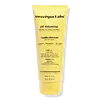What's inside
What's inside
 Key Ingredients
Key Ingredients

No key ingredients
 Benefits
Benefits

 Concerns
Concerns

 Ingredients Side-by-side
Ingredients Side-by-side

Water
Skin ConditioningAloe Barbadensis Leaf Juice
Skin ConditioningSodium Cocoyl Isethionate
CleansingCocamidopropyl Hydroxysultaine
CleansingSodium Lauroamphoacetate
CleansingCaprylyl/Capryl Glucoside
CleansingGlycol Distearate
EmollientSodium Methyl Cocoyl Taurate
CleansingPropanediol
SolventButyrospermum Parkii Butter
Skin ConditioningHelianthus Annuus Seed Oil
EmollientCocos Nucifera Oil
MaskingPrunus Armeniaca Kernel Oil
MaskingSimmondsia Chinensis Seed Oil
EmollientPanthenol
Skin ConditioningBetaine
HumectantHydroxypropyl Guar Hydroxypropyltrimonium Chloride
Citric Acid
BufferingXanthan Gum
EmulsifyingTrisodium Ethylenediamine Disuccinate
Ethylhexylglycerin
Skin ConditioningBenzoic Acid
MaskingPhenoxyethanol
PreservativeParfum
MaskingWater, Aloe Barbadensis Leaf Juice, Sodium Cocoyl Isethionate, Cocamidopropyl Hydroxysultaine, Sodium Lauroamphoacetate, Caprylyl/Capryl Glucoside, Glycol Distearate, Sodium Methyl Cocoyl Taurate, Propanediol, Butyrospermum Parkii Butter, Helianthus Annuus Seed Oil, Cocos Nucifera Oil, Prunus Armeniaca Kernel Oil, Simmondsia Chinensis Seed Oil, Panthenol, Betaine, Hydroxypropyl Guar Hydroxypropyltrimonium Chloride, Citric Acid, Xanthan Gum, Trisodium Ethylenediamine Disuccinate, Ethylhexylglycerin, Benzoic Acid, Phenoxyethanol, Parfum
Glycerin
HumectantWater
Skin ConditioningCocamidopropyl Betaine
CleansingDisodium Cocoamphodiacetate
CleansingHippophae Rhamnoides Fruit/Seed Oil
AntimicrobialRosa Canina Fruit Oil
EmollientSimmondsia Chinensis Seed Oil
EmollientSqualane
EmollientPyrus Malus Fruit Extract
Skin ConditioningPolyquaternium-10
Maltodextrin
AbsorbentSorbitan Oleate Decylglucoside Crosspolymer
CleansingPhenoxyethanol
PreservativeCocos Nucifera Fruit Extract
EmollientVanilla Planifolia Fruit Extract
Skin ConditioningGardenia Jasminoides Fruit Extract
Cosmetic ColorantEugenia Caryophyllus Flower Extract
AstringentPrunus Armeniaca Fruit Extract
Skin ConditioningPrunus Persica Fruit Extract
AbrasiveCitric Acid
BufferingEthylhexylglycerin
Skin ConditioningTetrasodium Glutamate Diacetate
Glycerin, Water, Cocamidopropyl Betaine, Disodium Cocoamphodiacetate, Hippophae Rhamnoides Fruit/Seed Oil, Rosa Canina Fruit Oil, Simmondsia Chinensis Seed Oil, Squalane, Pyrus Malus Fruit Extract, Polyquaternium-10, Maltodextrin, Sorbitan Oleate Decylglucoside Crosspolymer, Phenoxyethanol, Cocos Nucifera Fruit Extract, Vanilla Planifolia Fruit Extract, Gardenia Jasminoides Fruit Extract, Eugenia Caryophyllus Flower Extract, Prunus Armeniaca Fruit Extract, Prunus Persica Fruit Extract, Citric Acid, Ethylhexylglycerin, Tetrasodium Glutamate Diacetate
 Reviews
Reviews

Ingredients Explained
These ingredients are found in both products.
Ingredients higher up in an ingredient list are typically present in a larger amount.
Citric Acid is an alpha hydroxy acid (AHA) naturally found in citrus fruits like oranges, lemons, and limes.
Like other AHAs, citric acid can exfoliate skin by breaking down the bonds that hold dead skin cells together. This helps reveal smoother and brighter skin underneath.
However, this exfoliating effect only happens at high concentrations (20%) which can be hard to find in cosmetic products.
Due to this, citric acid is usually included in small amounts as a pH adjuster. This helps keep products slightly more acidic and compatible with skin's natural pH.
In skincare formulas, citric acid can:
While it can provide some skin benefits, research shows lactic acid and glycolic acid are generally more effective and less irritating exfoliants.
Most citric acid used in skincare today is made by fermenting sugars (usually from molasses). This synthetic version is identical to the natural citrus form but easier to stabilize and use in formulations.
Read more about some other popular AHA's here:
Learn more about Citric AcidEthylhexylglycerin (we can't pronounce this either) is commonly used as a preservative and skin softener. It is derived from glyceryl.
You might see Ethylhexylglycerin often paired with other preservatives such as phenoxyethanol. Ethylhexylglycerin has been found to increase the effectiveness of these other preservatives.
Phenoxyethanol is a preservative that has germicide, antimicrobial, and aromatic properties. Studies show that phenoxyethanol can prevent microbial growth. By itself, it has a scent that is similar to that of a rose.
It's often used in formulations along with Caprylyl Glycol to preserve the shelf life of products.
This oil comes from the seeds of the desert shrub called Jojoba. It is more commonly known as jojoba oil, a non-comedogenic oil.
Jojoba oil does not contain fragrance and has many fatty-acids, making it a great soothing ingredient.
It also contains Vitamin E, a great moisturizing ingredient. Vitamin E is also an antioxidant and protects your skin against oxidative damage.
This ingredient humectant properties, meaning it helps draw moisture from the air. This helps keep your skin hydrated.
While jojoba has antibacterial properties, it is only able to kill some strains of bacteria.
Studies also show it helps in wound healing. In fact, Indigenous cultures have used jojoba as a moisturizer and to help treat burns for centuries.
Fun fact: Jojoba oil similar to natural human skin sebum, so it has a great effect on dry skin. It is also promising with helping to regulate sebum production.
Due to its fatty acid content, Jojoba oil may not be fungal acne safe. We recommend speaking with a professional if you have any concerns.
Learn more about Simmondsia Chinensis Seed OilWater. It's the most common cosmetic ingredient of all. You'll usually see it at the top of ingredient lists, meaning that it makes up the largest part of the product.
So why is it so popular? Water most often acts as a solvent - this means that it helps dissolve other ingredients into the formulation.
You'll also recognize water as that liquid we all need to stay alive. If you see this, drink a glass of water. Stay hydrated!
Learn more about Water